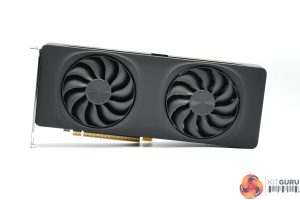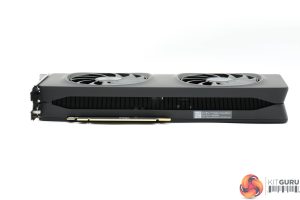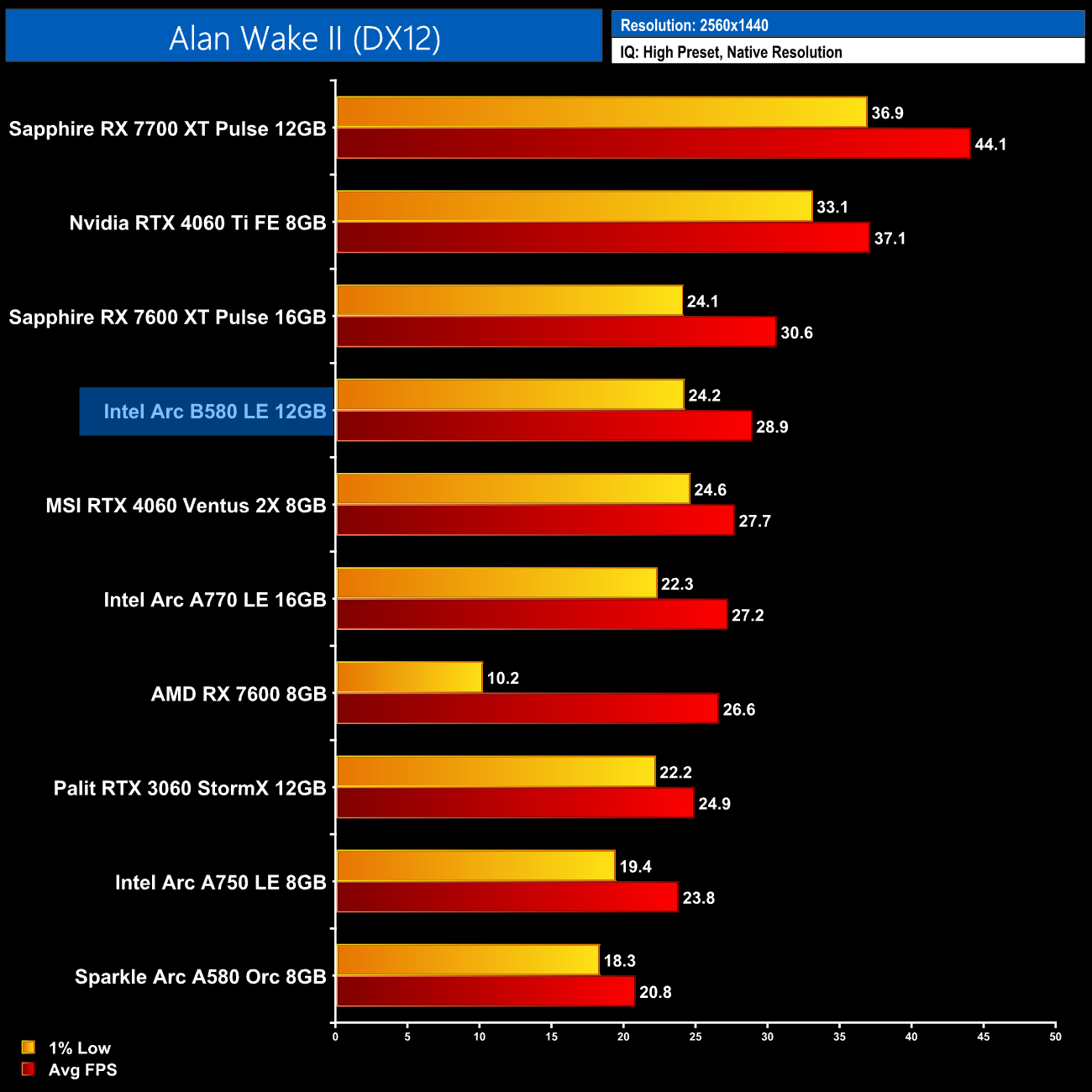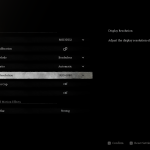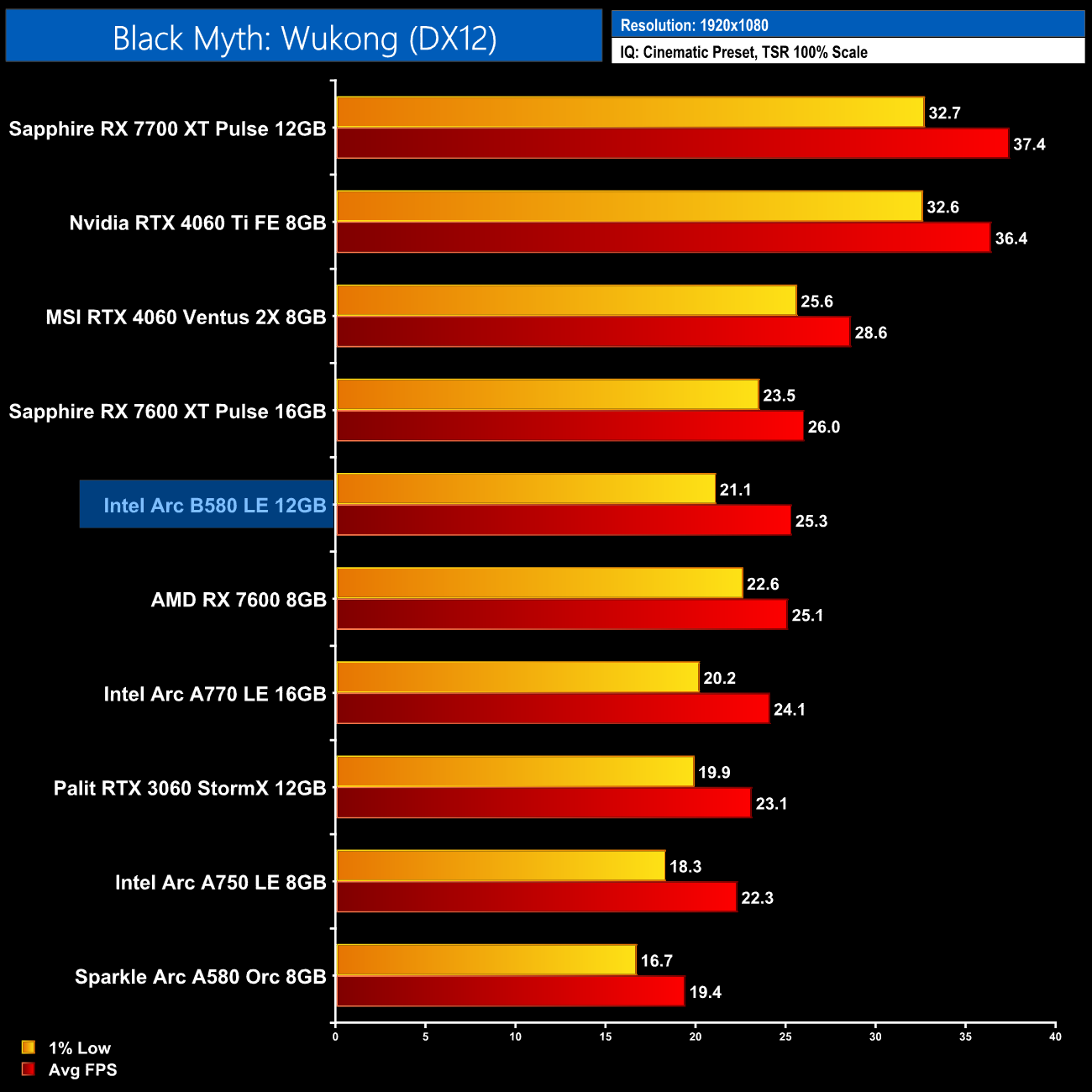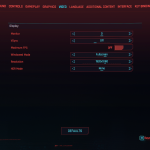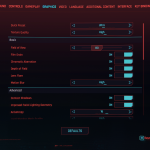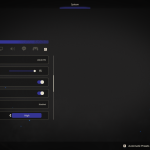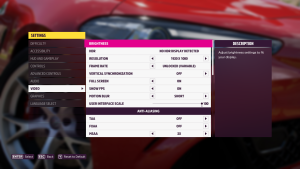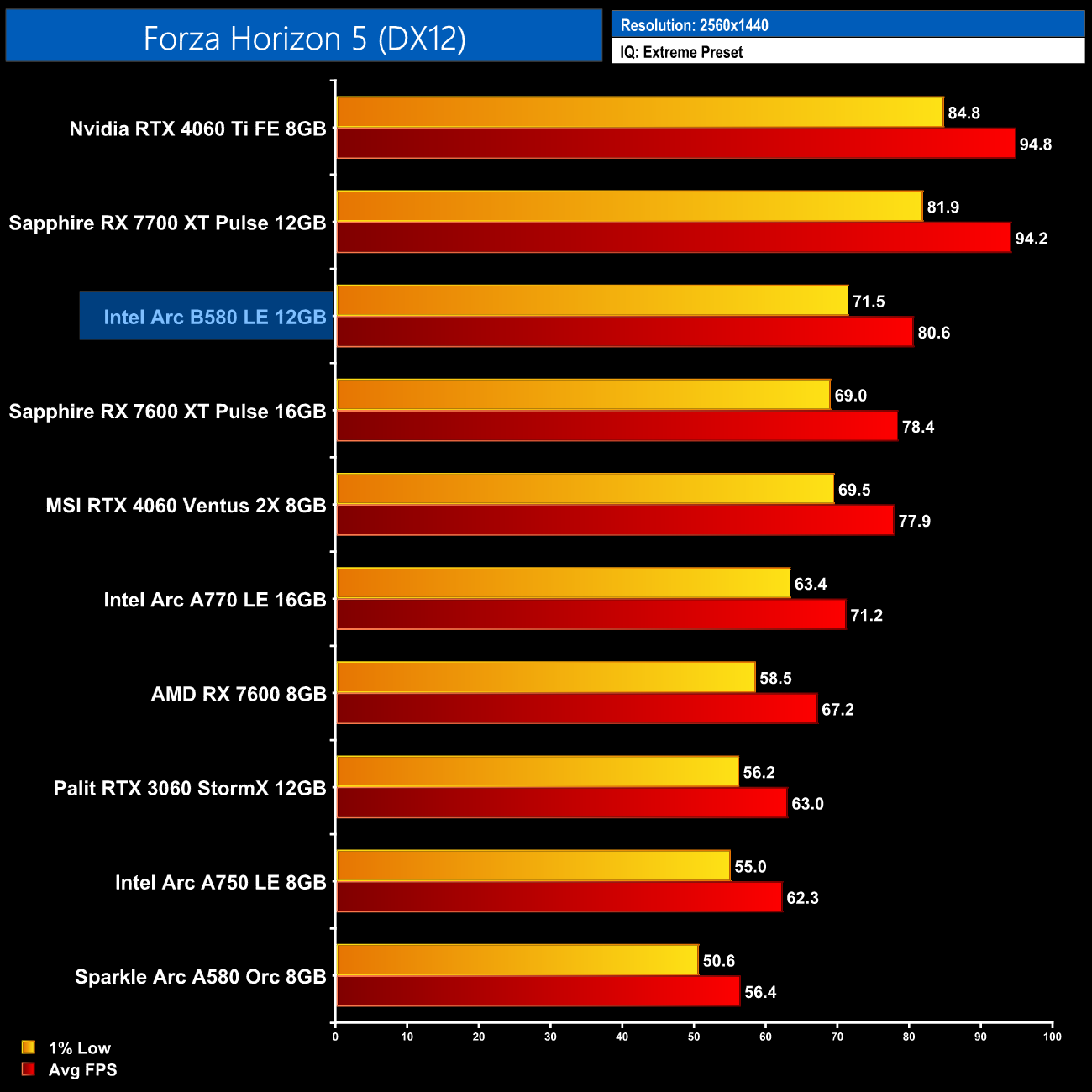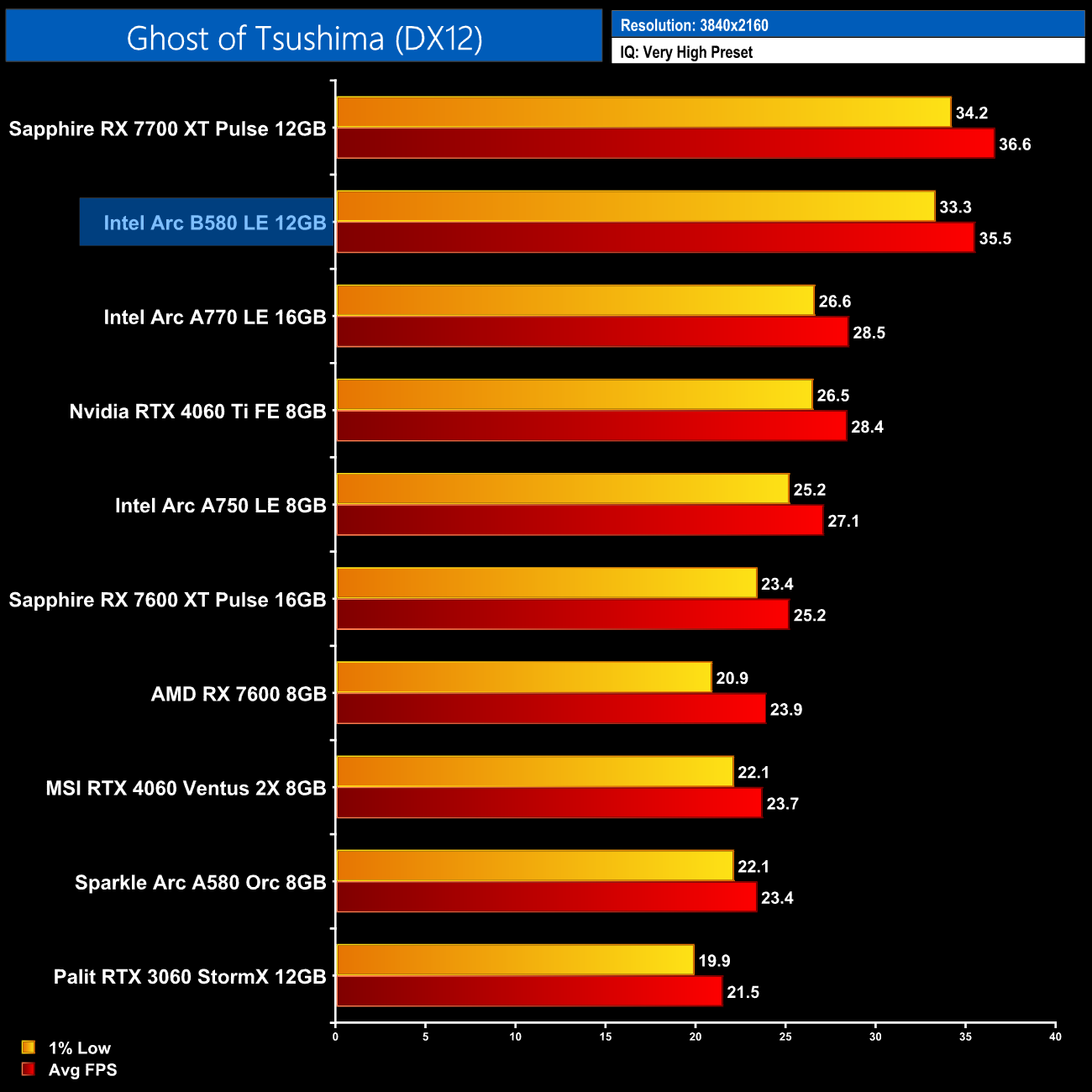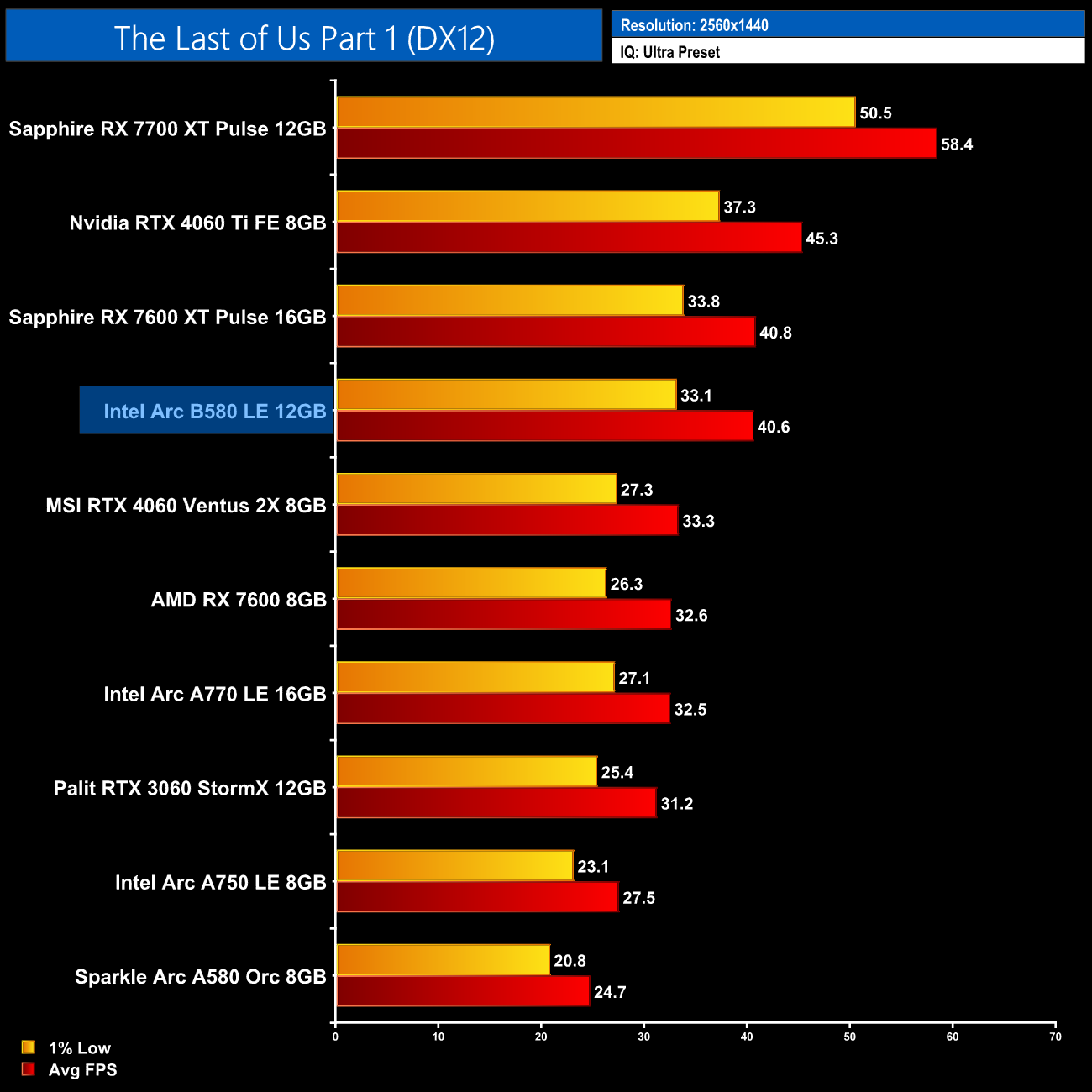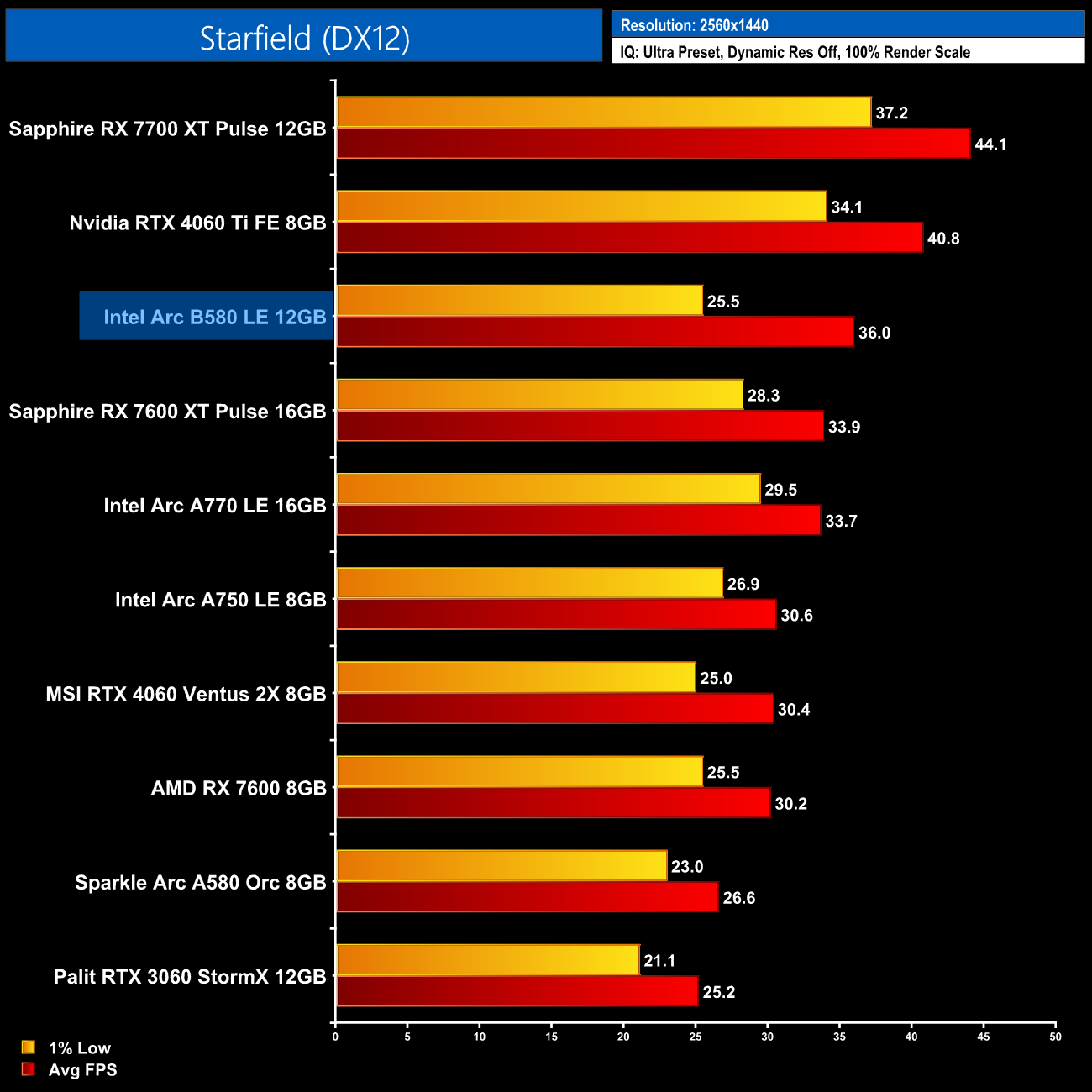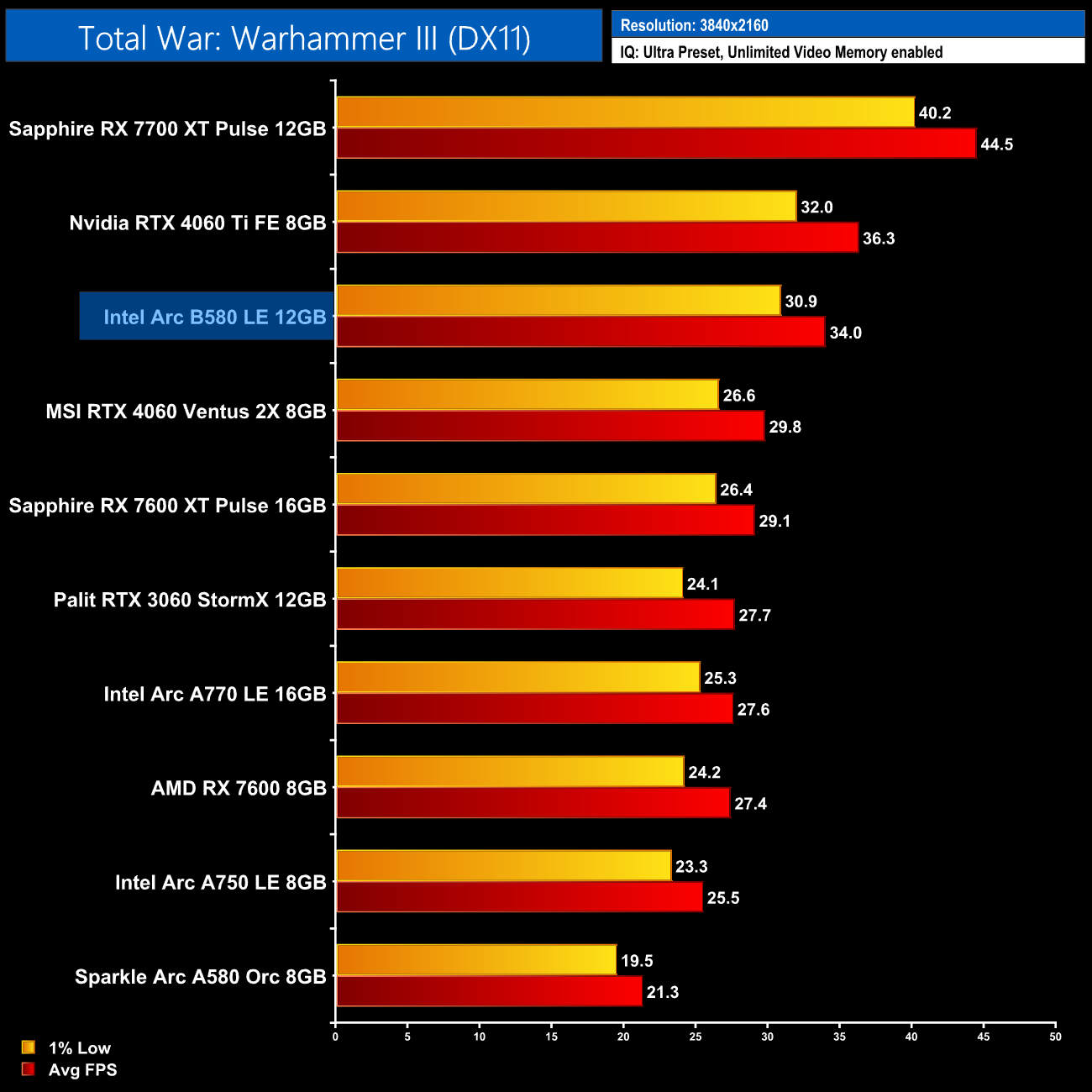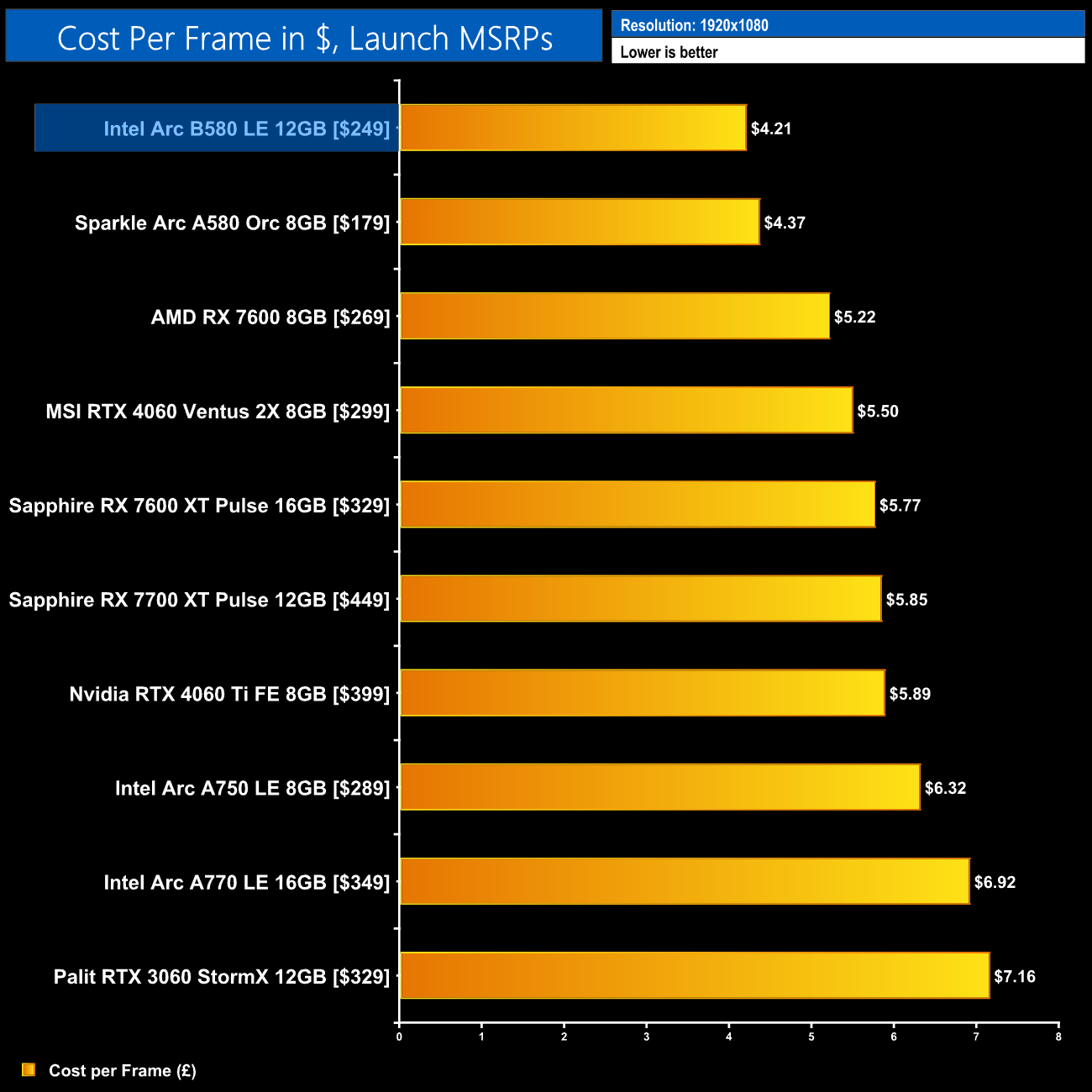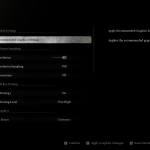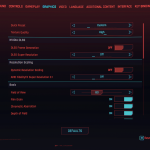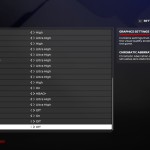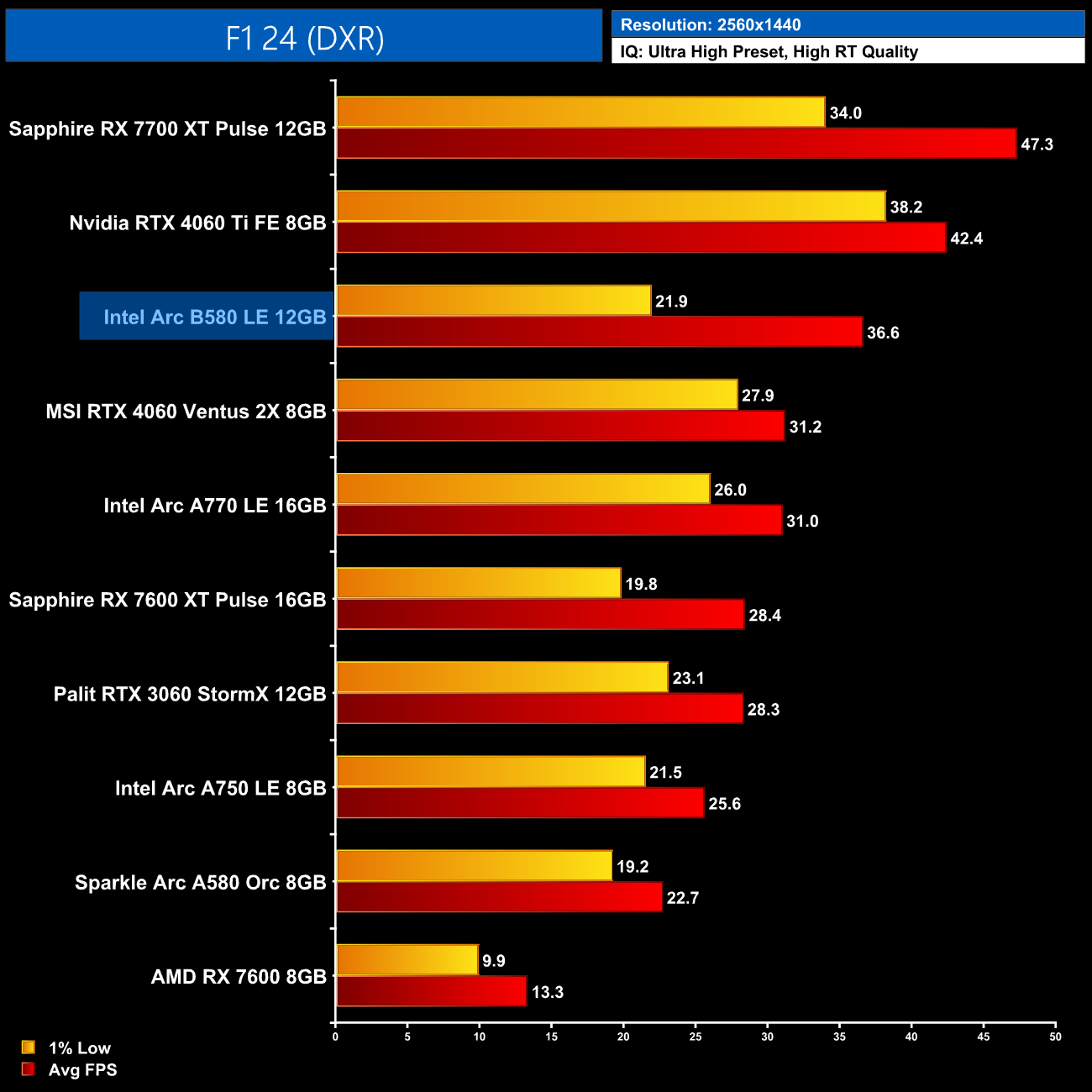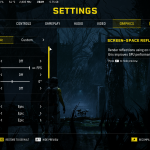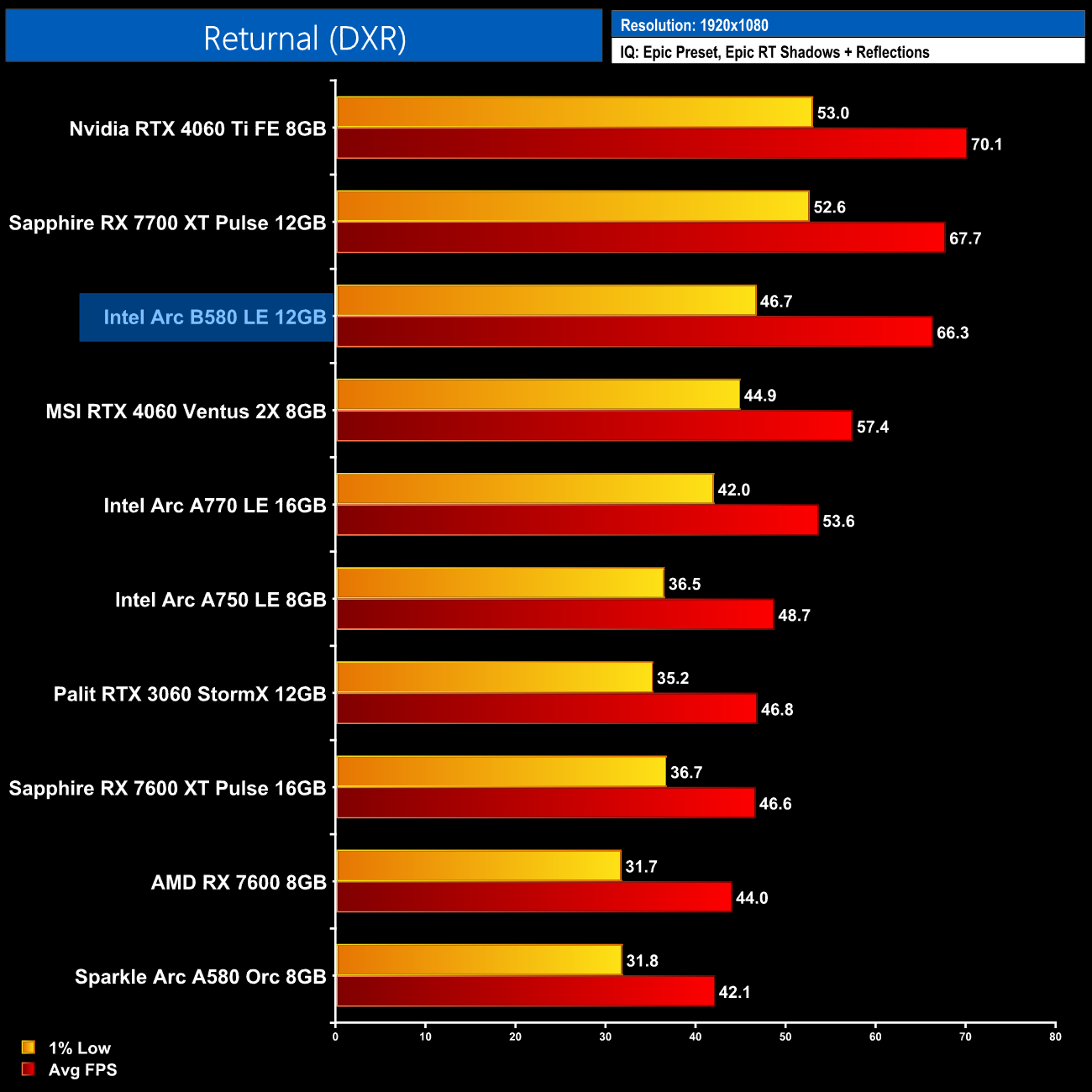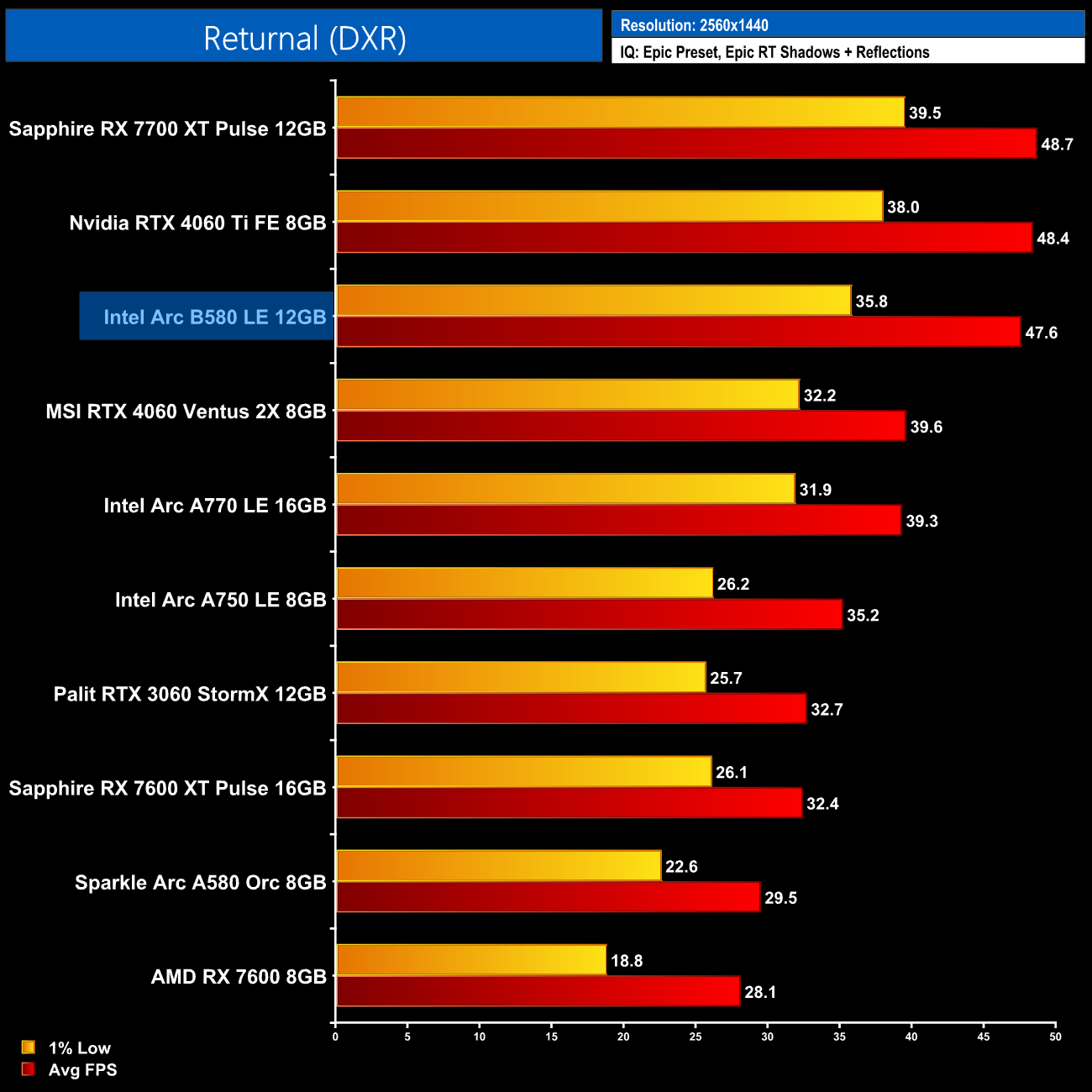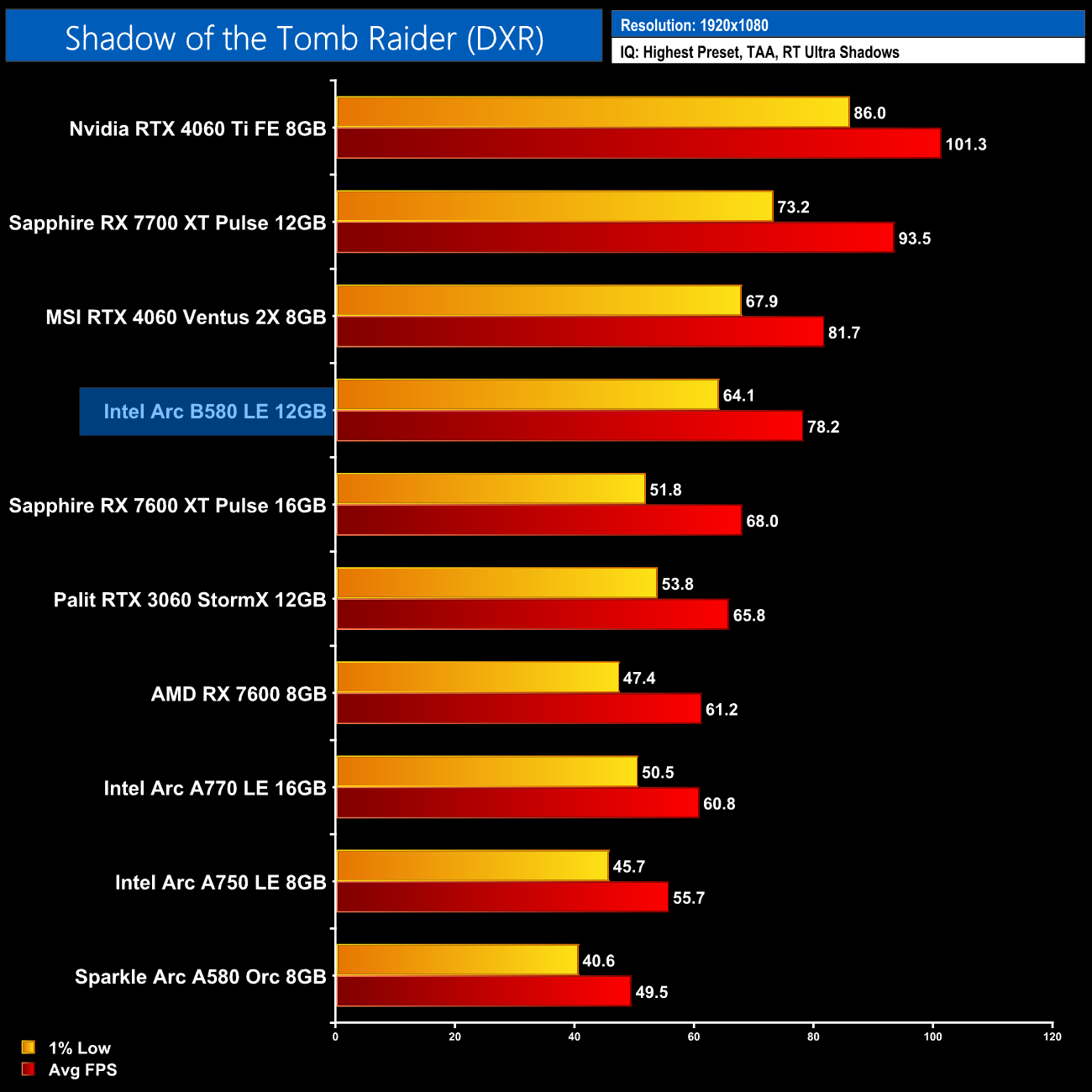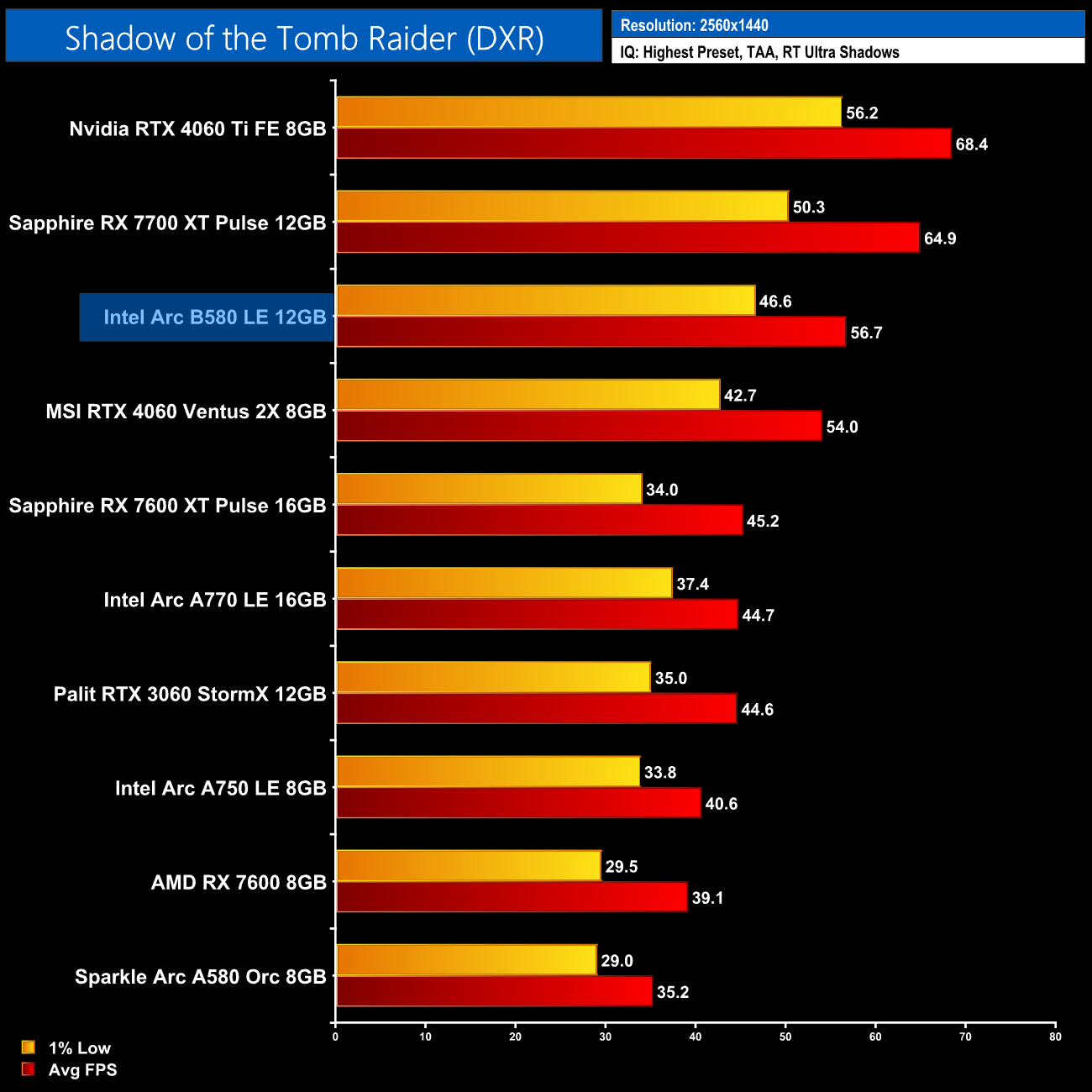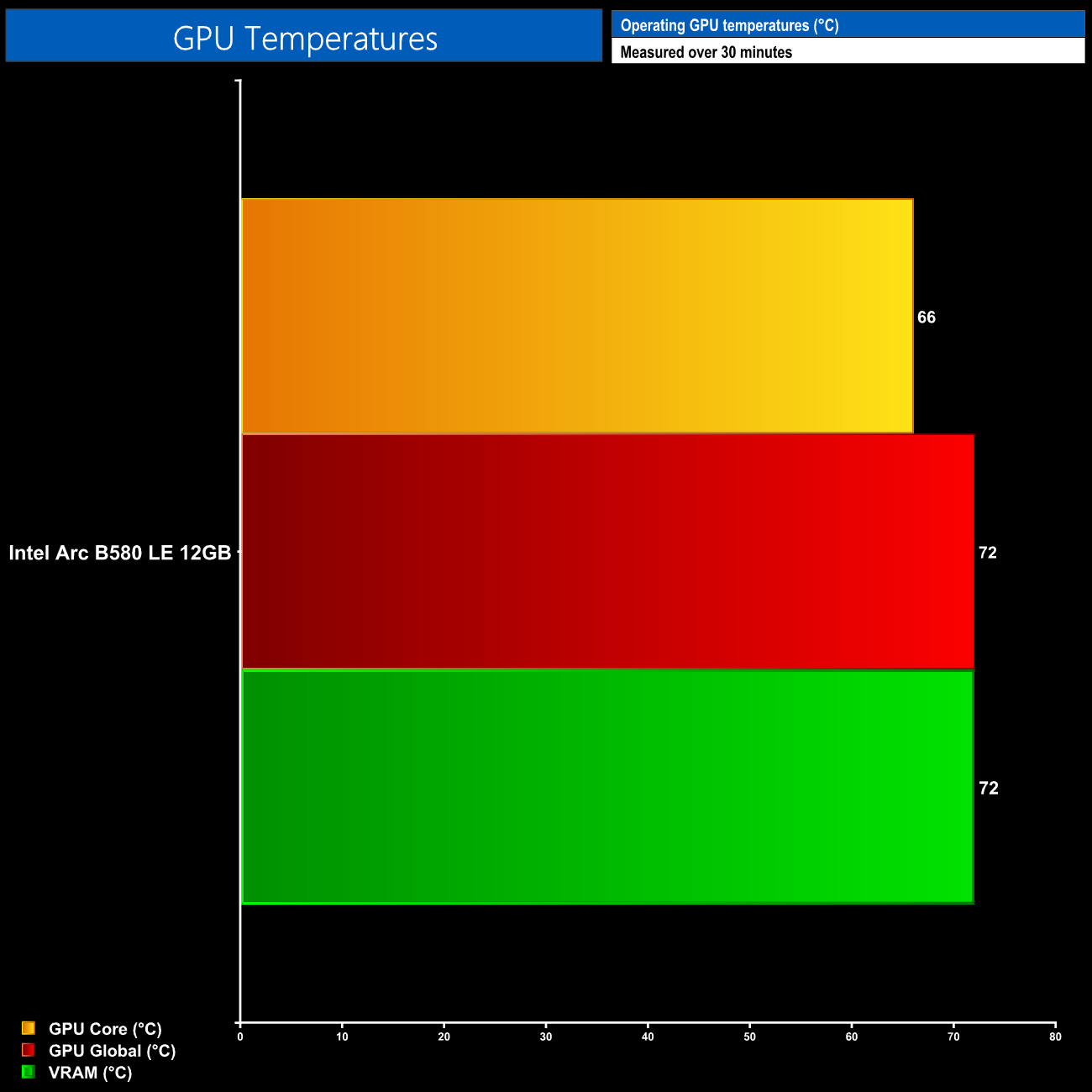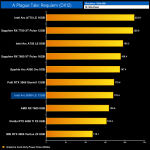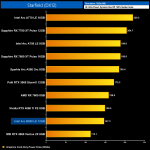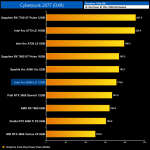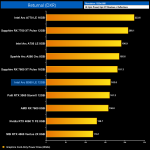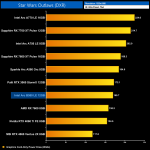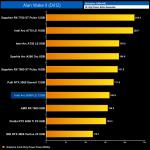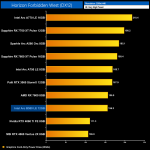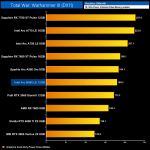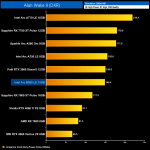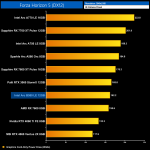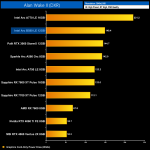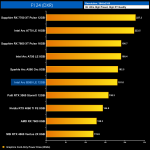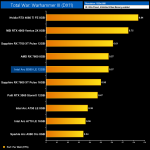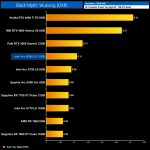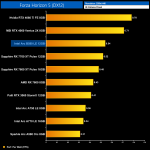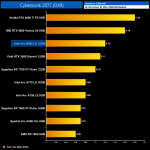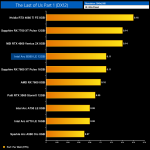
Two years on from the launch of Intel's Alchemist discrete GPUs, the next generation has arrived in the form of the Battlemage series, and today we can present our review of the Intel Arc B580. Hitting the market at $249, Intel claims the B580 is 10% faster than the Nvidia RTX 4060, while also offering superior cost per frame, alongside a larger 12GB framebuffer. It certainly sounds good on paper, but as you might have guessed, there's plenty more to the story…
Timestamps
00:00 Intro
00:42 Recapping the Battlemage GPUs
01:15 B580 core spec
02:09 Test setup
03:20 Alan Wake 2
04:09 Black Myth: Wukong
04:32 Cyberpunk 2077
05:15 Final Fantasy XVI
05:49 Forza Horizon 5
06:18 Ghost of Tsushima – stutter alert!
07:14 Horizon Forbidden West
07:52 The Last of Us Part 1
08:14 Plague Tale: Requiem
08:53 Senua’s Saga: Hellblade 2
09:24 Starfield
09:58 Total War: Warhammer III
10:37 12-game average results
11:36 Cost per frame ($)
12:49 RT Alan Wake II
13:25 RT Black Myth: Wukong
13:59 RT Cyberpunk 2077, hard locks galore
14:46 RT F1 24, frame time issues
15:45 RT Ratchet & Clank, more issues
16:19 RT Returnal
16:39 RT Shadow of the Tomb Raider
17:00 RT Star Wars Outlaws, crash city
17:32 RT 8-game average
18:34 Intel’s B580 Limited Edition card
19:22 Thermals and noise
19:58 Power draw and efficiency in-depth
21:40 Idle power draw and a quick fix
22:26 Closing thoughts
It's safe to say Intel's first discrete GPUs got off to a rocky start. Both the A770 and A750 launched with a myriad of driver issues, while performance didn't exactly blow us away against the likes of the RTX 3060 and RX 6600 XT. To Intel's credit, things certainly improved for Alchemist in a relatively short time frame, but we were never fully able to give those GPUs a wholehearted recommendation.
Now Intel is hoping its Arc B580 will be able to win wider appeal. Targeting the sub-$300 market, an area many believe to have been neglected by AMD and Nvidia, the B580 is taking the RTX 4060 and RX 7600 head on. But are Intel's performance claims true? Does the B580's value proposition stack up at he $249 asking price? And what of the drivers? All that and more is covered in today's review…
If you want to read this review as a single page, click HERE.
| Arc B580 | Arc A770 | Arc A750 | Arc A580 | Arc A380 | |
| Silicon | BMG-G21 | ACM-G10 | ACM-G10 | ACM-G10 | ACM-G11 |
| Process | TSMC N5 | TSMC N6 | TSMC N6 | TSMC N6 | TSMC N6 |
| Render Slices | 5 | 8 | 7 | 6 | 2 |
| Xe Cores | 20 | 32 | 28 | 24 | 8 |
| Shaders | 2560 | 4096 | 3584 | 3072 | 1024 |
| XMX Engines | 160 | 512 | 448 | 384 | 128 |
| RT Units | 20 | 32 | 28 | 24 | 8 |
| Texture Units | 160 | 256 | 224 | 192 | 64 |
| ROPs | 80 | 128 | 112 | 96 | 32 |
| Graphics Clock | 2670 MHz | 2100 MHz | 2050 MHz | 1700 MHz | 2000 MHZ |
| Memory Config | 12GB GDDR6 | 8/16GB GDDR6 | 8GB GDDR6 | 8GB GDDR6 | 6GB GDDR6 |
| Memory Data Rate | 19 Gbps | 17.5 Gbps | 16 Gbps | 16 Gbps | 15.5 Gbps |
| Memory Interface | 192-bit | 256-bit | 256-bit | 256-bit | 96-bit |
| Memory Bandwidth | 456 GB/s | 560 GB/s | 512 GB/s | 512 GB/s | 186 GB/s |
| PCIe Interface | Gen 4 x8 | Gen 4 x16 | Gen 4 x16 | Gen 4 x16 | Gen 4 x8 |
| TBP | 190W | 225W | 225W | 185W | 75W |
First, it's worth recapping the specs for this new GPU. Built on the Xe2 architecture, the B580 uses Intel's BMG-G21 die, fabricated on TSMC's N5 node, and it has a die size of 272mm2. Comprised of 5 render slices, that gives the chip a total of 20 Xe cores. Each Xe core offers 16 vector engines, with each vector engine housing eight FP32 ALUs, for a grand total of 2560. Each Xe core is accompanied by a Ray Tracing Unit, while we also find 160 TMUs and 80 ROPs.
The memory subsystem, meanwhile, is new for an Arc GPU. We find 12GB of GDDR6 operating over a 192-bit memory interface, and with memory speed at 19Gbps, total memory bandwidth hits 456 GB/s.
Intel has also been able to crank up the clock speed significantly with Battlemage, and the B580 has a rated graphics clock of 2670MHz, but a peak clock of 2850MHz.
Lastly, total board power is rated at 190W, something we look at closely in this review using our in-depth power testing methodology.
The Intel Arc B580 Limited Edition ships in a compact blue and purple box. The front is home to the Arc logo, while the back features a diagram of the graphics card itself, along with three areas Intel has decided to highlight – AI, ray tracing and content creation.
Inside, we find a small quick start guide, alongside some pieces of cardboard that can be folded to make a mini B580 GPU. A neat touch if that's your kind of thing.
As for the graphics card itself, it will quickly become clear that it shares much of the same design language as the A770 and A750 Limited Edition models. It has the same entirely matte black design, while it also sports two axial fans that measure 85mm in diameter.
I personally love the stripped-back, minimalistic aesthetic – there's no RGB or anything like that, it's just a smart-looking graphics card, and I know many of our readers have expressed positive feelings towards the A750 and A770 Limited Editions in the past.
It's a svelte graphics card, too, measuring 272 x 115mm, while it's a dual-slot thickness. Given it's a relatively low-power GPU we wouldn't have expected anything overly large, but in this day and age it's always appreciated when a graphics card is less than 30cm long!
The front side of the card is home to the Intel Arc logo, and this lights up with white LEDs once powered on. We can also get a look at the backplate, this time featuring a large cut-out to allow air to pass directly through the heatsink, something which should aid thermal performance.
Image above courtesy of Intel.
I've not yet disassembled the graphics card, but we get a look at the cooling solution in this image provided by Intel. The company is using four heatpipes alongside two vertically-oriented finstacks for cooling. We can also note a 6+2 phase configuration for the PCB.
Lastly, power is delivered by a single 8-pin connector. Display outputs consist of 3x DisplayPort 2.1 (2x UHBR10 and 1x UHBR 13.5) and 1x HDMI 2.1.
Driver Notes
- AMD GPUs were benchmarked with the Adrenalin 24.12.1 driver.
- Nvidia GPUs were benchmarked with the 566.14 driver.
- Intel GPUs (except B580) were benchmarked with the 101.6314 driver.
- Intel B580 was benchmarked with the 101.6251 driver supplied to press.
Results are only directly comparable where this exact configuration has been used.
Test System:
We test using a custom built system powered by MSI, based on AMD's Zen 5 platform.
| CPU |
AMD Ryzen 7 9800X3D
|
| Motherboard |
MSI MPG X870E Carbon WiFi
|
| Memory |
64GB (2x32GB) Kingston Fury Beast DDR5 6000MHz CL30
|
| Graphics Card |
Varies
|
| SSD |
4TB Kingston NV3 Gen 4 PCIe NVMe
|
| Chassis | MSI MPG Gungnir 300R Airflow |
| CPU Cooler |
MSI MAG CoreLiquid i360
|
| Power Supply |
MSI MEG Ai1300P
|
| Operating System |
Windows 11 23H2
|
| Monitor |
MSI MPG 321URX QD-OLED
|
| Resizable BAR |
Enabled for all supported GPUs
|
Comparison Graphics Cards List
- AMD RX 7600 8GB
- Sapphire RX 7600 XT Pulse 16GB
- Sapphire RX 7700 XT Pulse 12GB
- Sparkle Arc A580 Orc 8GB
- Intel Arc A750 LE 8GB
- Intel Arc A770 LE 16GB
- Palit RTX 3060 StormX 12GB
- MSI RTX 4060 Ventus 2X 8GB
- Nvidia RTX 4060 Ti FE 8GB
All cards were tested at reference specifications.
Software and Games List
- Alan Wake II (DX12)
- Black Myth: Wukong (DX12)
- Cyberpunk 2077 (DX12)
- F1 24 (DX12)
- Final Fantasy XVI (DX12)
- Forza Horizon 5 (DX12)
- Ghost of Tsushima (DX12)
- Horizon Forbidden West (DX12)
- The Last of Us Part 1 (DX12)
- A Plague Tale: Requiem (DX12)
- Ratchet and Clank: Rift Apart (DX12)
- Returnal (DX12)
- Senua's Saga: Hellblade 2 (DX12)
- Shadow of the Tomb Raider (DX12)
- Starfield (DX12)
- Star Wars Outlaws (DX12)
- Total War: Warhammer III (DX11)
We run each benchmark/game three times, and present mean averages in our graphs. We use FrameView to measure average frame rates as well as 1% low values (99th percentile) across our three runs.
Alan Wake 2 is a 2023 survival horror game developed by Remedy Entertainment and published by Epic Games Publishing. A sequel to Alan Wake, the story follows best-selling novelist Alan Wake, who has been trapped in an alternate dimension for 13 years, as he attempts to escape by writing a horror story involving an FBI special agent named Saga Anderson. The game was released for PlayStation 5, Windows, and Xbox Series X/S on 27 October 2023. (Wikipedia).
Engine: Northlight. We test using the High preset, FSR set to native resolution, DX12 API.
Our first game of the day is Alan Wake II, where at 1080p the B580 delivers 41fps, putting it dead level with Nvidia's RTX 4060. It's also just a handful of frames behind the RX 7600 and 7600 XT, but delivers a 24% uplift over the A750.
1440p is too stern a test without using some form of upscaling – which we do not test with – but the B580 is still very similar to the RTX 4060 and RX 7600 XT in terms of performance.
Alan Wake II also proved the start of some of our driver struggles that we will document today, with a couple of crashes to desktop during my testing. It's not the end of the world, but I didn't experience crashing in this game with any other GPU, so it's worth noting.
Black Myth: Wukong is a 2024 action role-playing game developed and published by Game Science. The game is inspired by the classical Chinese novel Journey to the West and follows an anthropomorphic monkey based on Sun Wukong from the novel. Black Myth: Wukong was released for PlayStation 5 and Windows on August 20, 2024, with an Xbox Series X/S version to be released at a later date. (Wikipedia).
Engine: Unreal Engine 5. We test using the Cinematic preset, TSR set to 100% render scale, DX12 API.
Black Myth: Wukong is a new addition to our test suite and I hadn't realised quite how punishing the Cinematic preset is! At native 1080p, this calibre of GPU struggles to hit 30fps, though we do see a 12% deficit for the B580 versus the RTX 4060.
Naturally that means 1440p is even less playable, so you'd really want to enable XeSS for smoother frame rates.
Cyberpunk 2077 is a 2020 action role-playing video game developed and published by CD Projekt. The story takes place in Night City, an open world set in the Cyberpunk universe. Players assume the first-person perspective of a customisable mercenary known as V, who can acquire skills in hacking and machinery with options for melee and ranged combat. Cyberpunk 2077 was released for Microsoft Windows, PlayStation 4, Stadia, and Xbox One on 10 December 2020. (Wikipedia).
Engine: REDengine 4. We test using the Ultra preset, FSR disabled, DX12 API.
As for Cyberpunk 2077, it's crazy to think this game is now four years old but it's still a great test for the modern GPU. As it happens, the B580 scales incredibly well here, delivering 84fps on average. That makes it 16% faster than the RTX 4060 and 22% ahead of the RX 7600.
Up at 1440p it fares even better against the competition, given it's now faster than the $400 RTX 4060 Ti, likely due to its increased memory bandwidth versus Nvidia's GPU. Against the the 4060, we're looking at a 32% uplift, and it's another 24% margin versus the A750.
Final Fantasy XVI is a 2023 action role-playing game developed and published by Square Enix. The sixteenth main instalment in the Final Fantasy series, it was released for the PlayStation 5 in June 2023, with a Windows version released in September 2024.
Engine: Square Enix in-house engine. We test using the Ultra preset, DLSS/FSR disabled, DX12 API.
Final Fantasy XVI is another new game for us and it's incredibly heavy on the GPU. The B580 only manages 32fps at native 1080p, resulting in limited gains of just 12% over the A750 – the least impressive generation gain that we'll see all day. Performance is still right in line with the RTX 4060, though.
1440p is out of the question unless you are willing to enable XeSS, or dial the image settings downs, given the B580 averaged just 24fps.
Forza Horizon 5 is a 2021 racing video game developed by Playground Games and published by Xbox Game Studios. The twelfth main instalment of the Forza series, the game is set in a fictionalised representation of Mexico. It was released on 9 November 2021 for Microsoft Windows, Xbox One, and Xbox Series X/S. (Wikipedia).
Engine: ForzaTech. We test using the Extreme preset, DX12 API.
Forza Horizon 5 is next and continues to impress with its level of optimisation. The B580 delivers nearly 100fps, even at Extreme settings, putting it on par with the RX 7600 XT and 6% ahead of the RTX 4060.
1440p is very playable too, with an average of 81fps, still right in line with the 4060 and 7600 XT, but also a 29% gain over the A750.
Ghost of Tsushima is a 2020 action-adventure game developed by Sucker Punch Productions and published by Sony Interactive Entertainment. The player controls Jin Sakai, a samurai on a quest to protect Tsushima Island during the first Mongol invasion of Japan.Ghost of Tsushima was released for the PlayStation 4 in July 2020, and an expanded version for PlayStation 4 and PlayStation 5, subtitled Director's Cut and featuring the Iki Island expansion, was released in August 2021. A Windows version of Director's Cut, developed by Nixxes Software, was released in May 2024. (Wikipedia).
Engine: Sucker Punch in-house engine. We test using the Very High preset, DX12 API.
Ghost of Tsushima is arguably the most impressive example of the B580's gaming prowess that we will see today. Despite initially offering very poor frametimes, a new driver that arrived earlier this week ironed out the issues and, with an average of 76fps, the B580 is even 14% faster than the RTX 4060 Ti 8GB, while it thumps the 4060 by a 39% margin!
Up at 1440p, that lead stretches to 43% versus the 4060 – and remember that Nvidia GPU is $40-50 more expensive. Versus the A750, we're looking at a 27% uplift gen-on-gen.
Just to demonstrate the improvement to frame times made by the newer driver, here I've compared the original data (6249) with the updated 6251 driver performance. As you can see, there were frequent spikes up to nearly 100ms (!) with the former driver, but the newer one does away with them almost entirely. I say ‘almost' as you can still see some tiny frame time jumps at similar intervals even with the 6251 driver, but they weren't noticeable during gameplay.
Horizon Forbidden West is a 2022 action role-playing game developed by Guerrilla Games and published by Sony Interactive Entertainment. The sequel to Horizon Zero Dawn (2017), the game is set in a post-apocalyptic version of the Western United States, recovering from the aftermath of an extinction event caused by a rogue robot swarm. The game and the Burning Shores expansion were collected together, re-released as Horizon Forbidden West Complete Edition for PlayStation 5 in October 2023, and ported to Windows by Nixxes Software in March 2024. A sequel is in development. (Wikipedia).
Engine: Decima. We test using the Very High preset, DX12 API.
Next up is Horizon Forbidden West, where at 1080p the B580 manages 65fps, giving it a 7% lead over the RTX 4060, and a whopping 58% lead over the RX 7600 which seems to be struggling, quite possibly due to VRAM. The B580's 1% lows aren't quite as good, however, scaling slightly worse than the RTX 4060.
At 1440p, that becomes even more stark as the 8GB drop away significantly – the B580 is now 39% faster than the RTX 4060, delivering a still very playable 51fps, so there is a clear benefit to more than an 8GB framebuffer.
The Last of Us Part I is a 2022 action-adventure game developed by Naughty Dog and published by Sony Interactive Entertainment. A remake of the 2013 game The Last of Us, it features revised gameplay, including enhanced combat and exploration, and expanded accessibility options. It was released for Microsoft Windows in March 2023. (Wikipedia).
Engine: Naughty Dog in-house engine. We test using the Ultra preset, DX12 API.
The Last of Us Part 1 is another title that is infamously VRAM-hungry, and that plays out in the B580's favour. It delivers huge gains over the likes of the A750 and RX 7600, while it's 13% ahead of the RTX 4060.
Up at 1440p, that gap widens to 22%, with the B580 managing 41fps at native resolution.
A Plague Tale: Requiem is an action-adventure stealth game developed by Asobo Studio and published by Focus Entertainment. It is the sequel to A Plague Tale: Innocence (2019), and follows siblings Amicia and Hugo de Rune who must look for a cure to Hugo's blood disease in Southern France while fleeing from soldiers of the Inquisition and hordes of rats that are spreading the black plague. The game was released for Nintendo Switch, PlayStation 5, Windows, and Xbox Series X/S on 18 October 2022. (Wikipedia).
Engine: Asobo Studio in-house engine. We test using the Ultra preset, DX12 API.
As for A Plague Tale: Requiem, the B580 manages 55fps on average, and that puts it 6% ahead of both the RTX 4060 and the RX 7600 XT. It's also good to see that Intel's B-series has cleared up an issue with the 1% lows that affects its first-gen Alchemist GPUs, so it's pleasing to see progress being made.
As for 1440p, the B580 scales even better at this resolution versus the RTX 4060 and RX 7600 XT, almost certainly due to its wider memory interface and increased memory bandwidth. It's 13% faster than the 4060 for instance, and not far off the 4060 Ti.
Senua's Saga: Hellblade II is a 2024 action-adventure game developed by Ninja Theory and published by Xbox Game Studios. The game serves as the sequel to Hellblade: Senua's Sacrifice (2017) and is set in 9th century Iceland, drawing inspiration from Norse mythology and culture. Senua's Saga: Hellblade II was released for Windows and Xbox Series X/S on 21 May 2024.
Engine: Unreal Engine 5. We test using the High preset, TSR set to 100% render scale, DX12 API.
Next we have another new addition to our roster, Senua's Saga: Hellblade II. Like Black Myth: Wukong, this is another Unreal Engine 5 title, and perhaps it's no coincidence that those are the only two games we tested where the B580 is slower than the RTX 4060 at 1080p – this time by a 12% margin.
It does close the gap at 1440p, reducing the deficit to just 3%, though the framerate has slipped to just 26fps, so you'd need to enable upscaling for smoother performance.
Starfield is a 2023 action role-playing game developed by Bethesda Game Studios and published by Bethesda Softworks. Announced in 2018, Starfield was delayed several times. The game was released for Windows and Xbox Series X/S on September 6, 2023. (Wikipedia).
Engine: Creation Engine 2. We test using the Ultra preset, with 100% resolution scale, dynamic resolution disabled, DX12 API.
As for Starfield, the B580 delivers 43fps on average, and while its only 6fps ahead of the RTX 4060 at 1080p, that works out as a 16% margin – not bad going. It's also about level with the RX 7600 XT, and 17% faster than the A750.
1440p performance also scales well, with the B580 now 18% ahead of the 4060 and 6% faster than the RX 7600 XT. Its 1% lows are slightly behind the competition however, but they're not awful.
Total War: Warhammer III is a turn-based strategy and real-time tactics video game developed by Creative Assembly and published by Sega. It is part of the Total War series, and the third to be set in Games Workshop's Warhammer Fantasy fictional universe (following 2016's Total War: Warhammer and 2017's Total War: Warhammer II). The game was announced on February 3, 2021 and was released on February 17, 2022. (Wikipedia).
Engine: TW Engine 3 (Warscape). We test using the Ultra preset, with unlimited video memory enabled, DX11 API.
Closing out with Total War: Warhammer III, this DX11 titles runs without a hitch on the B580 – in fact it runs brilliantly well, with the Battlemage GPU coming in 9% faster than the RTX 4060, and 5% ahead of the RX 7600 XT.
It's very playable at 1440p, too, still averaging over 60fps, while it holds leads of around 10% over both the RTX 4060 and RX 7600 XT.
Here we present frame rate figures for each graphics card, averaged across all 12 games on test today. These figures can disguise significant variations in performance from game to game, but provide a useful overview of the sort of performance you can expect at each resolution tested.
All in all, across the twelve games tested, the B580 delivered an average of 59fps at 1080p. That makes it 4% faster than the RX 7600 XT, 9% faster than the RTX 4060, while it offers a generation uplift of 29% over the A750. The leaks suggests RTX 4060 Ti-like performance weren't fully accurate, given the B580 is 13% slower.
Up at 1440p, it generally scales better versus its competition due to its wider 192-bit memory interface and the resulting increased memory bandwidth. Here we found it to be 16% faster than the RTX 4060, 9% ahead of the RX 7600 XT and still 27% faster than the A750, while it's only now 8% slower than the 4060 Ti 8GB.
The MSRPs
Using the average frame rate data presented earlier in the review, here we look at the cost per frame using the USD ($) MSRP launch prices for each GPU.
Using our data to calculate cost per frame, we can see that the B580 comes in at the top of the chart, delivering value that is clearly better than what either AMD or Nvidia can muster for this market segment. Versus the RX 7600 for instance, it represents a 19% improvement to cost per frame at 1080p, while that increases to 23% when compared against the RTX 4060.
At 1440p, it fares even better, now delivering cost per frame that's 25% lower than the RX 7600, and 28% better than the RTX 4060.
Current retail pricing
Things do change slightly when looking at the data based on current retail pricing, rather than MSRP figures. Even then however, the B580 is still clearly better value than its competition, with a 21% improvement to cost per frame versus the RTX 4060 at 1080p, and that increases to 25% at 1440p.
Alan Wake 2 is a 2023 survival horror game developed by Remedy Entertainment and published by Epic Games Publishing. A sequel to Alan Wake, the story follows best-selling novelist Alan Wake, who has been trapped in an alternate dimension for 13 years, as he attempts to escape by writing a horror story involving an FBI special agent named Saga Anderson. The game was released for PlayStation 5, Windows, and Xbox Series X/S on 27 October 2023. (Wikipedia)
Engine: Northlight. We test using the High preset, High Ray Tracing preset, FSR set to Quality upscaling, DXR API.
Starting our look at ray tracing performance with Alan Wake II, despite using Quality upscaling the B580 doesn't deliver playable frame rates at 1080p, falling to 23fps on average. We can clearly see it is streets ahead of the AMD competition however, and a whopping 62% faster than the A750, possibly due to its increased framebuffer. It's still 13% slower than the RTX 4060, though.
Black Myth: Wukong is a 2024 action role-playing game developed and published by Game Science. The game is inspired by the classical Chinese novel Journey to the West and follows an anthropomorphic monkey based on Sun Wukong from the novel. Black Myth: Wukong was released for PlayStation 5 and Windows on August 20, 2024, with an Xbox Series X/S version to be released at a later date. (Wikipedia).
Engine: Unreal Engine 5. We test using the Cinematic preset, Ray Tracing set to Very High, TSR set to 67% render scale, DXR API.
Next we have Black Myth: Wukong, and again we're upscaling here, but the B580 only managed 17fps, so it's actually no faster than the last-gen A770. Intel did say that their latest driver supplied to us during the review period included a fix for abnormally low ray tracing performance in Black Myth, but even after updating I didn't see any improvement. This game has clearly been designed with Nvidia hardware in mind, and you need an RTX 4060 Ti to even think about enabling the technology at 1080p.
Cyberpunk 2077 is a 2020 action role-playing video game developed and published by CD Projekt. The story takes place in Night City, an open world set in the Cyberpunk universe. Players assume the first-person perspective of a customisable mercenary known as V, who can acquire skills in hacking and machinery with options for melee and ranged combat. Cyberpunk 2077 was released for Microsoft Windows, PlayStation 4, Stadia, and Xbox One on 10 December 2020. (Wikipedia).
Engine: REDengine 4. We test using the Ray Tracing: Ultra preset, DXR API. DLSS/FSR are disabled.
As for Cyberpunk 2077, Intel are lucky that I decided to include this data. That's because the game actually hard locks when using ray tracing on the B580 if, according to Intel, you have an X670E or X870E motherboard. Intel's suggested workaround is to go into the graphics settings, hit F1 to reset the options to default, and then apply your desired settings, and you have to do this every time you close and re-open the game. Still, with perseverance I was able to gather the data, but it goes down as a very janky experience, though performance on par with the RTX 4060 is at least some kind of silver lining.
F1 24 is a racing video game developed by Codemasters and published by EA Sports. It is the sixteenth entry in the F1 series by Codemasters. It holds the official licence for the 2023 Formula One and Formula 2 championships. The game was released for Microsoft Windows, PlayStation 4, PlayStation 5, Xbox One, Xbox Series X/S, and Linux (through Valve's Proton compatibility layer) on 16 June 2023. (Wikipedia).
Engine: EGO. We test using the Ultra High preset, High ray tracing quality, DXR API. DLSS/FSR are disabled.
F1 24 is another game that gave me significant issues, with poor frametimes on show. Intel actually fixed the issues with one new driver, but that in turn broke frame generation, so Intel released another new driver which fixed frame gen, but that unfortunately saw the inconsistent frame times return. It's a shame as looking at the average FPS, the B580 actually has a healthy lead over the RTX 4060, but the 1% lows are noticeably worse and result in a choppy experience.
To illustrate that, above we can see a frame time plot looking at the 6251 driver vs the 6252 driver. As mentioned, the former is much more stable in terms of its frame times, whereas the newer drive delivers significantly more erratic performance.
Ratchet & Clank: Rift Apart is a 2021 third-person shooter platform game developed by Insomniac Games and published by Sony Interactive Entertainment for the PlayStation 5. It is the ninth main instalment in the Ratchet & Clank series and a sequel to Ratchet & Clank: Into the Nexus. Rift Apart was announced in June 2020 and was released on June 11, 2021. A Windows port by Nixxes Software was released on July 26, 2023. (Wikipedia).
Engine: Insomniac Games in-house engine. We test using the Very High preset, Very High ray tracing, DXR API. DLSS/FSR are disabled.
Unfortunately, Ratchet and Clank is yet another game where I encountered game-breaking issues. As shown in the video, every time I loaded into my save game to run a benchmark, the game slowed to a crawl and stuttered along for about 10 seconds, before it jolted into life and ran at seemingly normal frame rates. I have no idea why this was happening but it of course wrecks the benchmark numbers, and goes down as another issue that needs fixing.
Returnal is a 2021 roguelike video game developed by Housemarque and published by Sony Interactive Entertainment. It was released for the PlayStation 5 on April 30, 2021 and Windows on February 15, 2023. The game follows Selene Vassos, an astronaut who lands on the planet Atropos in search of the mysterious “White Shadow” signal and finds herself trapped in a time loop. (Wikipedia).
Engine: Unreal Engine 4. We test using the Epic preset, Epic ray traced shadows and reflections, DXR API. DLSS/FSR are disabled.
Thankfully, Returnal played nice with the B580 and actually delivered some very impressive numbers. With both RT reflections and shadows enabled, the Intel GPU came in 16% faster than the RTX 4060 and is basically on par with AMD's RX 7700 XT, so Battlemage is punching well above its weight here.
Shadow of the Tomb Raider is a 2018 action-adventure video game developed by Eidos-Montréal and published by Square Enix's European subsidiary. It continues the narrative from the 2015 game Rise of the Tomb Raider and is the twelfth mainline entry in the Tomb Raider series, as well as the third and final entry of the Survivor trilogy. The game was originally released worldwide for PlayStation 4, Windows, and Xbox One. (Wikipedia).
Engine: Foundation Engine. We test using the Highest preset, RT Ultra Shadows, DXR API. DLSS/FSR are disabled.
As for Shadow of the Tomb Raider, given it only incorporates ray traced shadows, this game is very light on ray tracing by modern standards. As such, the B580 is still able to hit 78fps maxed out at 1080p, and that makes it just 4% slower than the RTX 4060, but a good 15% faster than the RX 7600 XT.
Star Wars Outlaws is a 2024 action-adventure game developed by Massive Entertainment and published by Ubisoft. Set in the Star Wars universe between the events of The Empire Strikes Back (1980) and Return of the Jedi (1983), the story follows Kay Vess, a young scoundrel who assembles a team for a massive heist in order to pay off a crime syndicate. Star Wars Outlaws was released for PlayStation 5, Windows, and Xbox Series X/S on August 30, 2024.
Engine: Snowdrop. We test using the Ultra preset but with Nvidia RTXDI disabled, DXR API. DLSS/FSR are disabled.
Lastly, we finish up with Star Wars Outlaws. This is another game that really tried my patience, as I simply could not go more than one benchmark run at a time without it crashing – even when using Intel's newest driver which supposedly fixes the issue. Again, like Cyberpunk 2077, the data is only really here as a guide, as in reality the game is simply not playable on the B580. Intel really needs to get things fixed up sooner rather than later.
Ray tracing 8-game average fps
Overall, across the eight games I tested with ray tracing enabled, the B580 is able to push out 42fps on average at 1080p. That makes it 3% slower than the RTX 4060 overall – and that includes an absolute beating in Black Myth: Wukong – so considering the price differential, I'd say that's a very good result. Compared to AMD, the B580 is streets ahead, coming in 31% faster than the RX 7600 XT.
The snag – apart from the two games which were effectively unplayable! – is the B580's 1% lows are noticeably worse than the RTX 4060, with F1 24 and Ratchet and Clank driving down the average result – it's 16% slower when looking at this metric, so hopefully Intel's driver team can bring the lows in-line with the average fps result (and fix the broken games).
Cost per frame, launch MSRP data
Ray tracing cost per frame paints a clear picture – there's no GPU on the market offering better value than the B580 when it comes to ray traced performance, and it's not even close.
Cost per frame, current pricing data
The same goes when looking at data based on current retailing pricing, as the top four spots are all held by Intel GPUs when looking at the 1440p data.
Here we present the average clock speed for each graphics card while running A Plague Tale: Requiem for 30 minutes. We use GPU-Z to record the GPU core frequency during gameplay. We calculate the average core frequency during the 30 minute run to present here.
Real-world clock speed behaviour is very interesting, perhaps because it is so boring – the B580 clocked in at 2850MHz and did not budge during my testing. It literally ran at that frequency all day long, across every one of my benchmarks. Usually a completely fixed frequency plot suggests the GPU is not power limited, perhaps voltage or even clock limited, but the behaviour is very clear indeed. It'll be interesting to see if any of Intel's partners are able to improve on this with their custom cards.
For our temperature testing, we measure the peak GPU core temperature under load. A reading under load comes from running A Plague Tale: Requiem for 30 minutes.
Thermally, the Intel-made Limited Edition is highly impressive. The GPU core hit just 66C after our thirty minute stress test, while both the GPU global and VRAM metrics hit 72C, so those are very low temperatures across the board.
We take our noise measurements with the sound meter positioned 1 foot from the graphics card. I measured the noise floor to be 32 dBA, thus anything above this level can be attributed to the graphics cards. The power supply is passive for the entire power output range we tested all graphics cards in, while all CPU and system fans were disabled. A reading under load comes from running A Plague Tale: Requiem for 30 minutes.
The B580 is able to maintain such low temperatures while also running the fans very slowly. In my testing, they only ramped to about 1370rpm during our thirty minute stress test, resulting in a noise reading of 33dba. It's not silent, but it's very, very quiet.
Here we present power draw figures for the graphics card-only, on a per-game basis for all twelve games we tested at 1080p. This is measured using Nvidia's Power Capture Analysis Tool, also known as PCAT. You can read more about our updated power draw testing methodology HERE.
Per-Game Results at 1080p:
Click to enlarge.
12-Game Average at 1080p:
Power draw and efficiency was a problem area for Intel's Alchemist GPUs, but they have made clear strides with Battlemage in this area. Averaged over the twelve games I tested, at 1080p the B580 drew 151.3W, less than the RX 7600 and only slightly more than the RTX 4060 Ti 8GB.
Ray tracing results
As a bonus, we now include the power figures for all eight games we test with ray tracing enabled.
8-Game ray tracing average:
As expected, this number does rise when looking at ray tracing power draw, given the GPU load is generally higher.
Here we present power draw figures for the graphics card-only, on a per-game basis for all twelve games we tested at 1440p. This is measured using Nvidia's Power Capture Analysis Tool, also known as PCAT. You can read more about our updated power draw testing methodology HERE.
Per-Game Results at 1440p:
Click to enlarge.
12-Game Average at 1440p:
Even at 1440p, the B580 doesn't draw close to its 190W TBP, averaging 160.6W in my testing. That's about 30W less than the A750, despite being significantly faster, so that bodes well for our efficiency data which we'll get to in a minute.
Ray tracing results
As a bonus, we now include the power figures for all eight games we test with ray tracing enabled.
8-Game ray tracing average:
Power draw for ray tracing at 1440p is again slightly higher, this time hitting 164.6W.
Here we present power draw figures for the graphics card-only, on a per-game basis for all twelve games we tested at 2160p (4K). This is measured using Nvidia's Power Capture Analysis Tool, also known as PCAT. You can read more about our updated power draw testing methodology HERE.
Per-Game Results at 2160p (4K):
Click to enlarge.
12-Game Average at 2160p (4K):
4K data isn't hugely relevant to this class of GPU, but it's here if you want it.
Ray tracing results
As a bonus, we now include the power figures for all eight games we test with ray tracing enabled.
8-Game ray tracing average:
The same goes for 4K ray tracing figures – power actually drops slightly as the GPU is often bandwidth starved at these settings, resulting in power dips.
Using the graphics card-only power draw figures presented earlier in the review, here we present performance per Watt on a per-game basis for all twelve games we tested at 1080p.
Per-Game Results at 1080p:
Click to enlarge.
12-Game Average at 1080p:
As we thought, overall efficiency has come on hugely versus Alchemist. Intel claims a 50% improvement to performance per Watt, a figure I was able to match exactly when comparing the B580 to the A750 at 1080p. That does mean the B580 lags behind the RTX 40-series and Ada Lovelace, but it's already on par – if not slightly more efficient than RDNA 3, so I'd say this is a hugely impressive leap for just a single generation.
Ray tracing results
As a bonus, we now include the power figures for all eight games we test with ray tracing enabled.
8-Game ray tracing average:
Ray tracing efficiency also scales similarly, with the B580 delivering 53% more performance per Watt than the A750.
Using the graphics card-only power draw figures presented earlier in the review, here we present performance per Watt on a per-game basis for all twelve games we tested at 1440p.
Per-Game Results at 1440p:
Click to enlarge.
12-Game Average at 1440p:
The overall trend stays the same at 1440p, too. We're again looking at exactly 50% more performance per Watt than the A750, though the B580 is 18% behind the RTX 4060 here.
Ray tracing results
As a bonus, we now include the power figures for all eight games we test with ray tracing enabled.
8-Game ray tracing average:
Nvidia widens the gap when looking at ray tracing efficiency, given the B580 is 25% less efficient than the RTX 4060.
Using the graphics card-only power draw figures presented earlier in the review, here we present performance per Watt on a per-game basis for all twelve games we tested at 2160p (4K).
Per-Game Results at 2160p (4K):
Click to enlarge.
12-Game Average at 2160p (4K):
Again, 4K data isn't overly relevant to this market sector, but we have recorded it anyway!
Ray tracing results
As a bonus, we now include the power figures for all eight games we test with ray tracing enabled.
8-Game ray tracing average:
The same can also be said for ray tracing efficiency at 4K – it's not a realistic scenario for this class of GPU.
We measure system-wide power draw from the wall while running A Plague Tale: Requiem for 30 minutes (4K resolution).
We close out with a look at total system power draw, and as expected overall power is quite low. I measured the system pulling 310W at the wall, so a reduction of about 35W compared to the A750.
It's been over two years since Intel's first-generation Alchemist GPUs hit the market, but the time has now come for Battlemage. Launching first with the B580, this 12GB GPU is priced at $249 and it is clearly Intel's best discrete GPU to-date.
That all starts with the performance, as it turns out Intel's overall claims were pretty accurate. For 1080p gaming, we found the B580 to be 9% faster on average than Nvidia's RTX 4060, while it's 4% ahead of the AMD RX 7600 XT. That works out as a 29% gen-on-gen uplift versus the A750, and it's only 13% behind the RTX 4060 Ti 8GB.
Interestingly, the B580 scales better versus the competition at 1440p, where we found it to be 16% faster on average than the RTX 4060 and 9% ahead of the RX 7600 XT. The snag is it lacks the GPU horsepower required to be properly effective at that resolution, at least not without enabling XeSS or lowering image quality settings.
Black Myth: Wukong aside, ray tracing performance is also generally competitive with the RTX 4060, while the B580 is streets ahead of the RX 7600 XT in this area. I'd still argue that raster performance is the most important factor for a GPU of this class, as overall frame rates aren't particularly high when RT is enabled, but there is clearly scope to experiment if you are happy to tinker with upscaling.
That performance data translates into a favourable value analysis, too, at least when looking at prices in the US. Based on current dollar pricing, we found the B580 offers a 13% improvement to cost per frame when compared against the RX 7600, and that stretches to a 21% margin up against the RTX 4060. It's impressive stuff and highlights just how far Intel has come in the dGPU market.
As you might have guessed, there is a but coming, and the way I see it, it's a two-fold problem. The first thing to consider is that we are comparing the B580 to current-gen products from AMD and Nvidia which are nearing the end of their life cycle. The likes of the RX 7600 and RTX 4060, for instance, have already been on the market for eighteen months. If rumours are to be believed, both AMD and Nvidia will unveil their next-gen architectures in January, with a possible RTX 5060 rumoured for March or April 2025.
Of course, nothing is a given in this industry until it happens, but I do think it's a fair point to make that the B580 is going up against some now fairly tired competition. Yes, it does look like good value today, but it's simply realistic to suggest that most of the B580's life cycle will be in competition with RDNA 4 and the RTX 50-series, rather than products on the market right now, so it will have to continue offering impressive value well into the future.
The other factor that needs discussion is, of course, Intel's drivers. We've seen how far things have come in this regard, and I have no doubt that things will continue to get better. The fact remains that, unfortunately, I've just had too many headaches over the last week to be able to put this area of discussion to bed.
During this review period I've encountered non-stop game crashes in Star Wars Outlaws, hard locks in Cyberpunk 2077 when ray tracing is enabled, inconsistent frametimes in F1 24 and Ghost of Tsushima, woeful ray tracing performance in Black Myth: Wukong, alongside performance grinding to a near-standstill in Ratchet and Clank: Rift Apart. Even frame generation stopped working in the only game that currently supports Intel's implementation of the technology! It doesn't help that Intel provided us with multiple driver/software updates over the review period, something which just gives the impression the B580 isn't ready for prime time, and the driver team has been scrambling to catch up as a result. Even now, certain games are basically unplayable on the GPU, and that's never a good place to be at launch.
To give Intel their due, I believe them when they say they are committed to continuously improving – we've already seen Alchemist comes on leaps and bounds. But even then, this last week has shown me that competing products like the RTX 4060 and RX 7600 will offer a better experience in terms of game stability across the board, and that means we can't yet recommend this new GPU outright. The B580 clearly has potential, so if Intel can quickly establish a positive track record for Battlemage with its driver releases, that could change in the future – but right now, there is much more work for Intel to do.
The B580 will be available at retail as of December 13th, with an MSRP of $249.
Update: The B580 Limited Edition is up for pre-order at £248.99 from OCUK HERE.
Discuss on our Facebook page HERE.
Pros
- Generally faster than the RTX 4060 and RX 7600 for rasterisation.
- Ray tracing performance is competitive with RTX 4060 and miles ahead of the RX 7600 (if the game doesn't crash!)
- 12GB VRAM is great for the price.
- Enticing value proposition at $249.
- Efficiency has come on hugely since Alchemist.
- Quiet and cool Limited Edition card.
Cons
- Drivers remain a real battle for the B580, with some games completely unplayable at launch.
- Other titles exhibited frame time issues, generally low performance or graphical glitches.
- Next-gen GPUs are on the horizon from both AMD and Nvidia, which could affect the B580's value proposition.
- Efficiency still lags behind the RTX 40-series.
KitGuru says: Arc has come a long way since the launch of Alchemist, and while the B580 shows clear promise, there is still plenty of work to be done if Intel wants to crack the mainstream market.
 KitGuru KitGuru.net – Tech News | Hardware News | Hardware Reviews | IOS | Mobile | Gaming | Graphics Cards
KitGuru KitGuru.net – Tech News | Hardware News | Hardware Reviews | IOS | Mobile | Gaming | Graphics Cards








